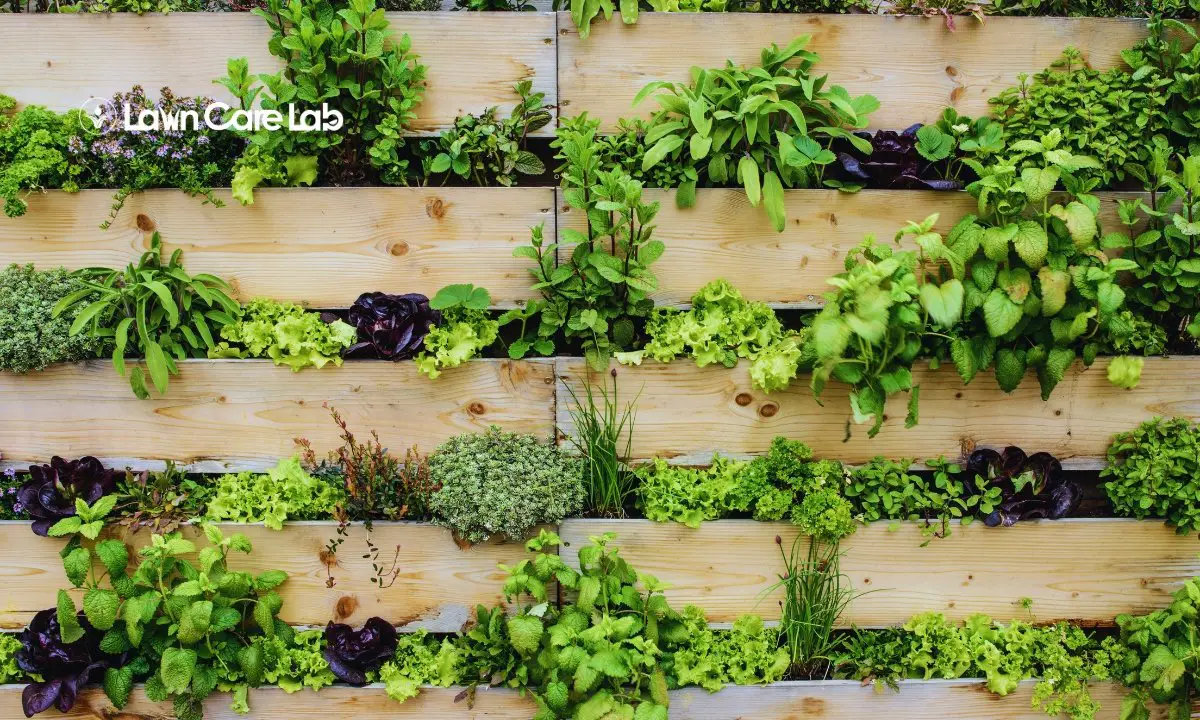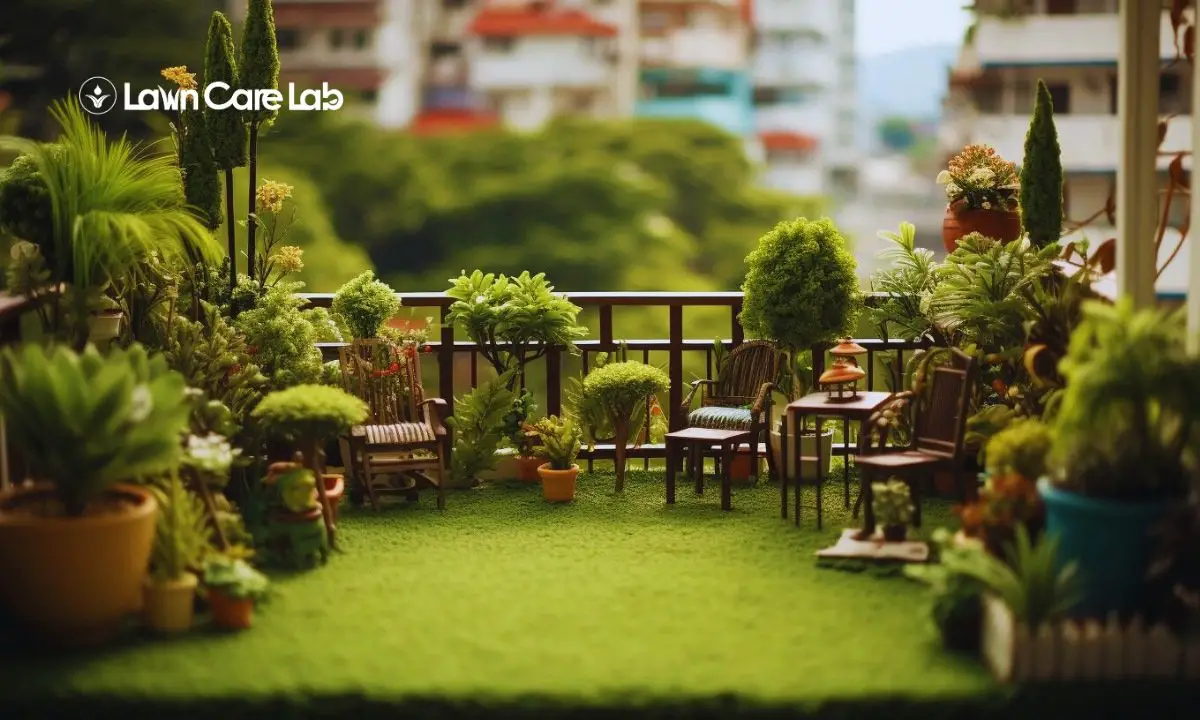Vertical gardening offers a creative and space-efficient way to transform your outdoor area into a lush, vibrant space.
By using strong supports and carefully selected climbing plants, you can elevate the beauty of your lawn while making the most of limited space. This method not only adds visual interest but also enhances the functionality of your garden.
With the right setup, including sturdy structures and efficient watering systems like drip irrigation, you can create a thriving vertical garden.
This guide provides practical tips to help you design, install, and maintain a vertical garden that is both aesthetically pleasing and easy to manage.
Table of Contents
Key Takeaways
- Find sunny spots in your yard with strong support for healthy plant growth.
- Use trellises, wall planters, and hanging baskets to create height and add visual interest to your yard while maximizing space.
- Choose plants like clematis or ivy that thrive in your yard’s light conditions and complement its look. For example, clematis is great for spots with lots of sunlight.
- Mix various plants and colors to create an attractive and vibrant yard.
- Consider setting up a drip irrigation system for efficient watering in your vertical garden, saving water and time.
Understanding Vertical Gardening
Vertical gardening transforms walls into vibrant, green spaces by growing plants upward, making it ideal for limited spaces. This method not only beautifies your home but also creates a serene, natural environment. Imagine fresh herbs on your kitchen wall or a living room adorned with ferns and succulents, each adding texture and seasonal color.
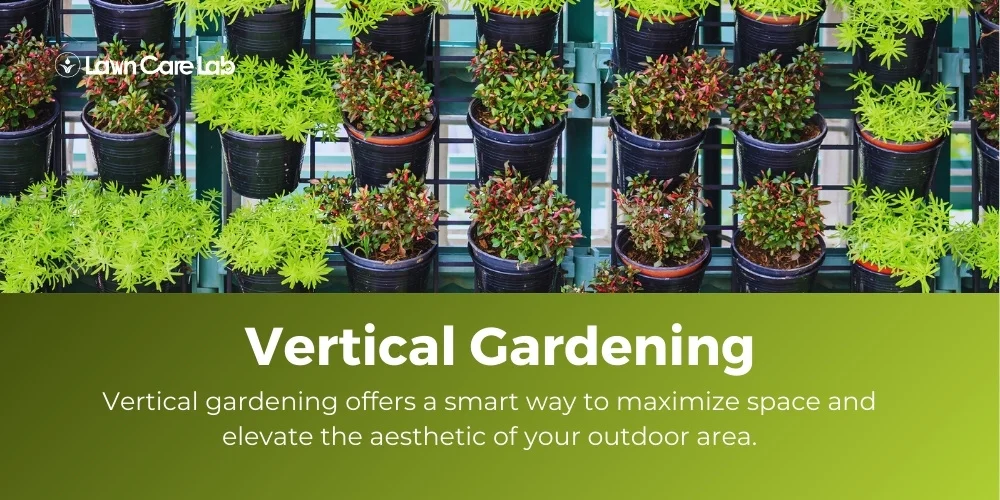
Vertical gardens offer practical benefits, such as air purification and cooling effects, making them perfect for urban living. Starting is simple with modular planters like the ‘Gronomics Vertical Garden Bed,’ which is easy to install and enhances both aesthetics and indoor health.
Choosing the Right Location
Selecting the right spot for your vertical garden is key to its success.
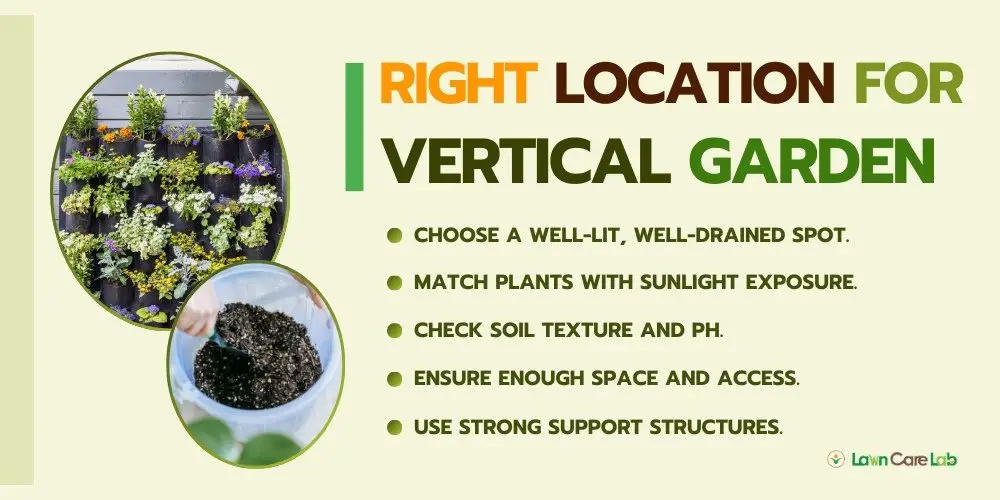
The ideal location should offer sufficient sunlight, proper soil drainage, and ample room for plants to grow both upward and outward.
Assessing Sunlight Exposure
To ensure your plants thrive, evaluate the sunlight in your chosen area:
- Morning vs. Afternoon Sun: Some plants prefer gentle morning light, while others need a stronger afternoon sun. Match your plants with the appropriate light conditions.
- Shade Patterns: Monitor where shadows fall throughout the day to protect sensitive plants from the harsh midday sun.
- Seasonal Sunlight: Consider how the sun’s path changes with the seasons to ensure consistent light year-round.
Evaluating Soil Quality
After checking how much sunlight your garden will get, the next step is to look at the soil quality to ensure it’s good for growing plants.
Begin by feeling the soil texture. It should be soft and easy to crumble, making it easy for plant roots to grow deeply. The soil shouldn’t be too sandy or too clayey. Sandy soil lets water drain away too fast, and clayey soil holds too much water, which can harm plant growth.
Next, you need to check the soil’s pH level, which tells you how acidic or alkaline the soil is. Most plants do best in soil that’s slightly acidic to neutral. You can use a home testing kit or get a professional to test the soil for you. Adjusting the soil’s pH might sound difficult, but it helps your plants absorb nutrients better.
Choosing the right spot for your garden is crucial because it affects how well your plants will grow.
Considering Space Availability
Space is crucial for the growth and health of your vertical garden:
- Sunlight Exposure: Ensure the area receives enough sunlight, especially for sun-loving plants like tomatoes, which need 6-8 hours of daily light.
- Accessibility: Choose a spot that’s easy to reach for watering and maintenance, keeping gardening enjoyable and manageable.
- Structural Support: For vertical gardening, ensure your walls or trellises are sturdy enough to support the plants. Consider using a durable trellis, like the Heavy-Duty Trellis, to support climbing plants effectively.
Selecting Suitable Structures
When planning a vertical garden, it’s essential to choose sturdy, aesthetically pleasing supports that complement the design of your home.
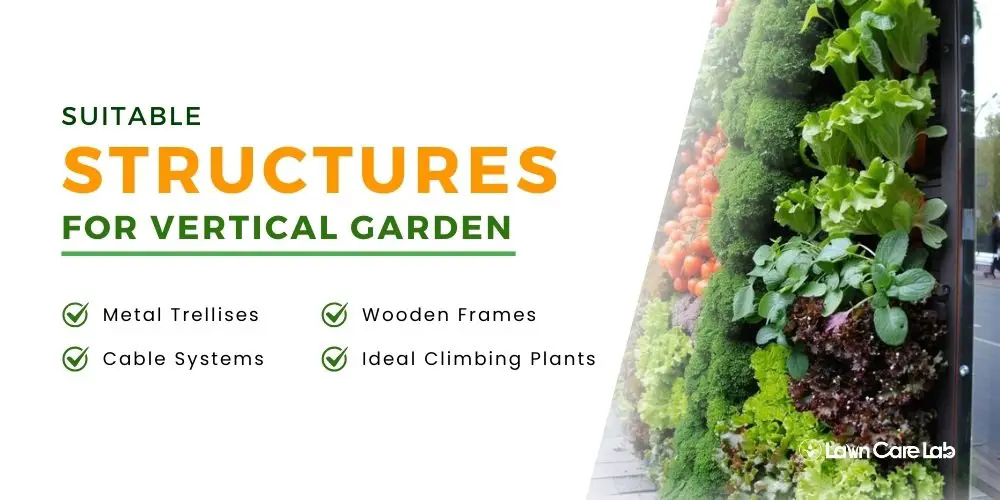
Assess the available space to ensure your plants don’t overcrowd, which could hinder their growth.
Select climbing plants that are well-suited to your setup, such as ivy or climbing roses, which can beautifully cover a wall and bring it to life.
Choosing Durable Support Types
For a thriving vertical garden, opt for strong and durable supports that also match your garden’s style
Here are some solid choices:
- Metal Trellises: These are great because they’re strong and have a sophisticated look. They can easily hold up heavier plants.
- Wooden Frames: These give a natural look that goes well with plants. Just make sure the wood is treated to prevent decay and keep insects away.
- Cable Systems: These are ideal for a contemporary style. They’re adjustable to accommodate growing plants and work well in versatile spaces.
Choosing the right support will help your vertical garden stay beautiful and thriving. Make sure to consider how each option fits with your garden’s style and needs.
Assessing Space Requirements
After selecting your supports, determine the space they will occupy and how they’ll integrate with your garden.
Here’s a straightforward guide for planning:
| Structure Type | Space Requirement |
| Trellis | 3 feet wide x 6 feet high |
| Vertical Pallet | 4 feet wide x 5 feet high |
| Hanging Planters | 2 feet wide x adjustable height |
| Wall Planters | 5 feet wide x 5 feet high |
Choose structures that fit your space and style, ensuring a harmonious blend of beauty and functionality.
For smaller areas, hanging planters offer adjustable heights, making them ideal for compact spaces.
Larger gardens might benefit from a striking trellis or vertical pallet, which supports upward growth and adds a visual centerpiece.
Ideal Climbing Plants
Selecting the right climbing plants enhances the beauty of your garden and ensures ease of maintenance:
- Clematis: These plants are known for their bright flowers in various colors, making them great for adding vibrant touches.
- Jasmine: The sweet scent of jasmine can make your garden smell wonderful.
- Ivy: If you need to cover a space quickly, Ivy is perfect. It grows fast and provides greenery throughout the year.
Choose climbers that thrive in your climate and soil, creating a stunning and low-maintenance vertical garden that reflects your personal style and love for the outdoors.
Picking the Perfect Plants
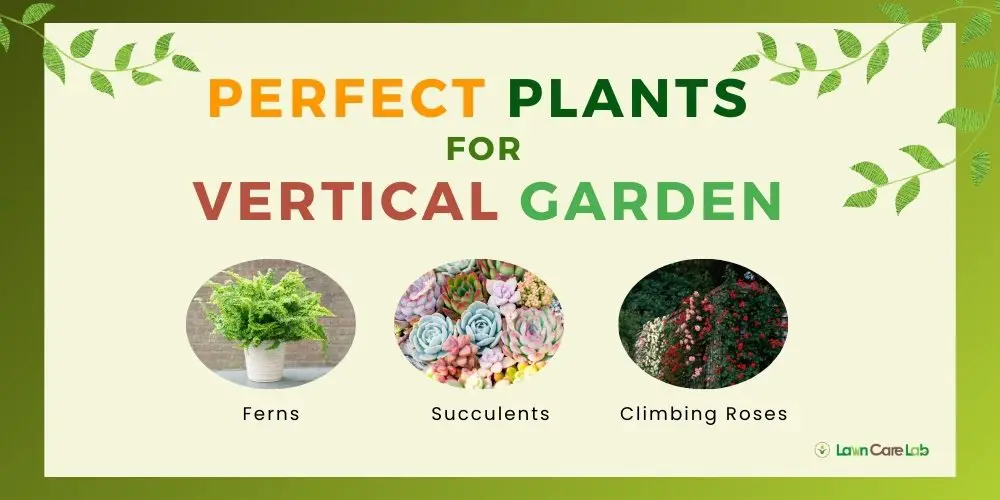
To keep your vertical garden healthy, regularly check the soil moisture and water thoroughly, but avoid overwatering. This promotes strong root growth and reduces maintenance.
Here’s a simple guide:
| Plant Type | Benefits |
| Ferns | They bring a rich, green look and are great for shaded areas. |
| Succulents | They don’t need much water, making them ideal for places that get a lot of sun and have dry soil. |
| Climbing Roses | They provide a touch of romance and are available in many colors. |
Adjust your watering with the seasons and your plants’ needs. Use a long-spout watering can for even distribution and easy access to all areas of your garden.
Integrating Vertical Elements
Enhance your garden’s aesthetics and functionality by integrating vertical elements. Here’s how:
- Trellises: Ideal for climbing plants like ivy, clematis, or morning glories, trellises add height and greenery. They guide plant growth, creating a natural, living wall.
- Wall-mounted Planters: Perfect for herbs or small plants such as succulents, these planters utilize vertical space on empty walls, bringing life to overlooked areas.
- Hanging Baskets: Suspended from pergolas or beams, hanging baskets add color and variety to higher spaces. They’re especially impactful when filled with vibrant flowers or trailing plants.
Watering and Maintenance Tips
Keep your vertical garden flourishing by regularly checking the soil moisture and watering thoroughly but sparingly. This encourages strong root growth, maintaining plant health and reducing maintenance efforts.
Here’s a straightforward guide to help you manage your watering schedule:
| Plant Type | Watering Needs |
| Ferns | High; keep the soil moist |
| Succulents | Low; water only when the soil is completely dry |
| Edible Herbs | Moderate; depends on the type of herb |
| Flowering Plants | Moderate to high; soil should be kept moist |
Adjust watering according to the seasons and plant needs. A long-spout watering can is ideal for evenly distributing water across your vertical garden.
Styling and Aesthetic Advice
Enhance your vertical garden’s appeal by choosing a mix of colors and textures that reflect your style and complement your home’s exterior.
Here are a few practical tips:
- Combine Different Plants: Use a mix of flowering plants and leafy greens. This contrast not only brings out the beauty of the flowers but also highlights the richness of the greens.
- Choose Complementary Colors: Pick plant colors that either match or contrast with your wall or trellis colors. For example, purple flowers can look stunning against a light yellow background.
- Add Lights: Place some gentle lights around your garden. This not only makes your garden stand out at night but also creates a cozy atmosphere.
Let your garden showcase your unique taste and style. Feel free to experiment and have fun with your choices!
Overcoming Common Challenges
Even with the best care, vertical gardens can face challenges, but practical solutions are available.
For example, one common challenge is not watering enough. To fix this, consider using a drip irrigation system. This system targets water directly to the plant roots, ensuring they get the moisture they need efficiently.
Light availability is another issue you might encounter if your garden isn’t in the best spot. If your garden lacks natural light, you can choose plants that do well in shade or use artificial grow lights that mimic sunlight. This ensures your plants get the light they need to grow.
Space can also be limited. To manage this, pick plant varieties that are smaller and train them to grow vertically instead of spreading out. This approach not only saves space but also makes your garden look more attractive.
You can maintain a vibrant and eye-catching vertical garden by addressing these challenges.
Conclusion
Vertical gardening offers a smart way to maximize space and elevate the aesthetic of your outdoor area. Studies show that vertical gardens can significantly boost plant growth compared to traditional methods. By choosing appropriate structures and plant varieties that align with your lawn’s layout, you can create a beautiful and efficient garden.
Regular care and thoughtful styling are key to maintaining a vibrant and productive vertical garden. With proper maintenance, your vertical garden will not only thrive but also become a stunning feature of your home.
Happy gardening!
- How to Create a Lawn Care Schedule for Southern Climates - October 30, 2024
- How to Use Compost Tea to Boost Lawn Growth and Soil Health - October 23, 2024
- The Best Grasses for Saltwater-Exposed Lawns: Coastal Lawn Care - October 17, 2024

